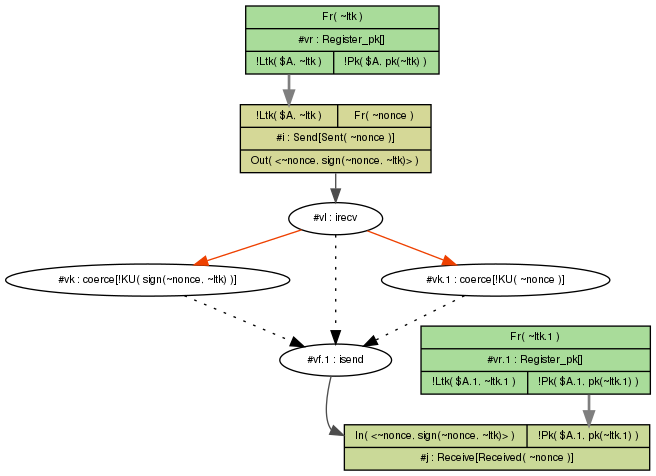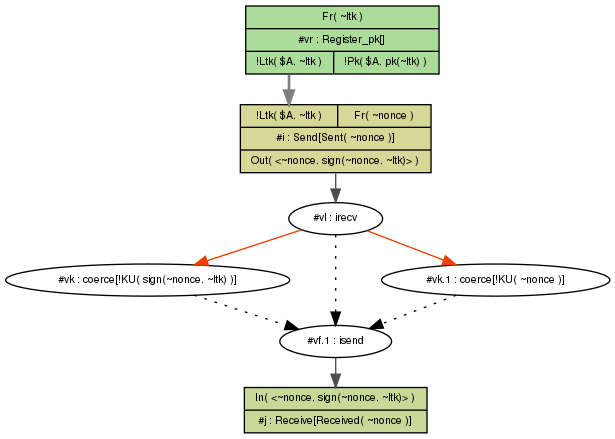Signature verification using pattern matching (without public key)
Daniel Andrade
- Shouldn't lemma functional fail to find a trace since the public key is not available in rule Received?
- In the first figure below, which is of a trace where the public key is available in rule Received, we have two rules Register_pk. In this case should we assume the ~ltk in the first Register_pk equals ~ltk.1 in the second Register_pk?
begin
builtins: signing
rule Register_pk:
[ Fr(~ltk) ] --> [ !Ltk($id, ~ltk), !Pk($id, pk(~ltk)) ]
rule Send:
let
signature = <~nonce, sign(~nonce, ~ltk)>
in
[ !Ltk($A, ~ltk), Fr(~nonce) ]
--[ Sent(~nonce) ]->
[ Out(signature) ]
rule Receive:
let
signature = <~nonce, sign(~nonce, ~ltk)>
in
[ In(signature)
// , !Pk($A, pub) // comment this: Receive will not have the public key
]
--[ Received(~nonce) ]->
[]
lemma functional: exists-trace
"Ex nonce #i #j. Sent(nonce) @ i & Received(nonce) @ j"
end


Ralf Sasse
Dear Daniel
Your rule does not do what you want it to do: the public key that you list is just an unrelated one.
rule Receive:
let
signature = <~nonce, sign(~nonce, ~ltk)>
in
[ In(signature)
// , !Pk($A, pub) // comment this: Receive will not have
the public key
]
--[ Received(~nonce) ]->
[]
the "pub" in the !Pk fact is just unrelated. It has to be "pk(~ltk)" to actually model a signature check. So you would rewrite your rule as such:
rule Receive:
let
signature = <~nonce, sign(~nonce, ~ltk)>
in
[ In(signature)
, !Pk($A, pk(~ltk)) // comment this: Receive will not have
the public key
]
--[ Received(~nonce) ]->
[]
for the version that checks the signature.
In the other version,
with that !Pk commented out, you want to model that the
signature verification key is not available from what you write,
however what you have modeled is that simply any input is
accepted and no check whatsoever is done, so this will always
succeed.There is no easy way to model this idea of the key not
being there without going much deeper into 'restrictions' that
disallow this.
Best regards,
Ralf
--
You received this message because you are subscribed to the Google Groups "tamarin-prover" group.
To unsubscribe from this group and stop receiving emails from it, send an email to tamarin-prove...@googlegroups.com.
To view this discussion on the web visit https://groups.google.com/d/msgid/tamarin-prover/d28b7f30-2186-4efa-b56f-664ab2a0f3d8n%40googlegroups.com.
